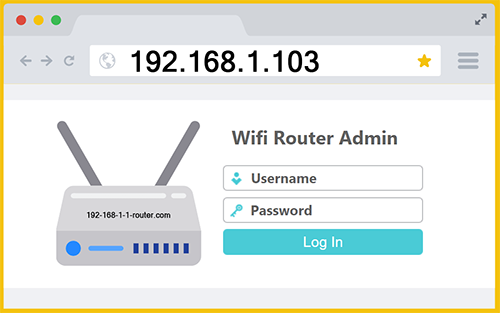192.168.1.103
 Guide to 192.168.1.103 Admin Login
Guide to 192.168.1.103 Admin Login
The IP address 192.168.1.103 is often assigned as the default gateway for specific routers or network devices, granting access to the device’s administrative interface. When entered into Chrome or Safari’s address bar, this IP opens a configuration panel where users can manage important settings. For example: from this dashboard, you can typically change the wireless network name and password.
How to Locate 192.168.1.103 Admin

To access the device’s settings, first make sure your phone is connected to the same WiFi network as the device. Then, open your browser and enter “192.168.1.103” directly into the address bar. This should bring up the login screen, where you’ll need to enter your username and password to proceed. You can also go directly to the login page by clicking this link:
Frequent username: admin
Frequent passwords: admin and password
If you enter https://192.168.1.103 into Google’s search bar instead of your browser’s address bar, your phone won’t connect to the device and will instead perform a standard web search. As a result, you’ll be shown a page of unrelated search results rather than a login screen. This happens because search engines are designed to retrieve information from the Internet, not to communicate with local network devices. To correctly access the device’s admin panel, the IP address must be entered directly into the URL bar at the top of your browser. This distinction ensures you’re connecting to your local device and not performing a search.
About 192.168.1.103
The IP address 192.168.1.103 is part of the private IPv4 address range defined by RFC 1918, commonly used within home and office networks. It typically serves as a local IP address assigned to a specific device by a router’s DHCP (Dynamic Host Configuration Protocol) system. In most networks, this address isn’t used as the default gateway but instead as a dynamically or statically assigned address for a computer, printer, smart TV, or even a secondary router or access point. It enables that device to communicate with others on the same network, as well as to access the Internet through the primary router.
In some cases, 192.168.1.103 might also be manually set as a static IP address, especially for devices that need a consistent connection point, such as surveillance cameras, media servers, or VoIP systems. Setting it as static can be useful when configuring port forwarding, ensuring that the device is always reachable at the same IP address without being reassigned by the router. This is especially important in environments where reliability and consistency are critical, such as in home automation or small business networks.
Though not commonly used as a default gateway, 192.168.1.103 could serve as the access point to a network device’s admin panel if manually configured that way. For example, if a user has a secondary router or Wi-Fi extender set up with this IP, they can type it into a browser’s address bar to access that device’s settings. From there, they can manage features such as wireless channels, security settings, or firmware updates. However, this only works if 192.168.1.103 is correctly configured on the device and there’s no IP conflict with other devices on the network.
If you’re trying to access a router or network device through 192.168.1.103 and it isn’t responding, it’s possible the device has been assigned a different IP or is not currently connected to the network. You can use tools like ipconfig on Windows or Network Utility on macOS to check the local IPs of connected devices. Alternatively, you can log in to your main router, usually via 192.168.1.1 admin / 192.168.l.l admin, to view the list of connected devices and their assigned IPs. This helps ensure you’re targeting the right address for configuration or troubleshooting purposes.
192.168.103
IP address 192.168.103 is not valid because it’s missing a critical part of the standard IPv4 structure, which requires four octets separated by periods (e.g., 192.168.1.103). With only three segments, 192.168.103 is incomplete and cannot be interpreted properly by your device or browser. This formatting error often occurs when users accidentally omit a section while typing. To fix it, simply ensure the address has four full octets by changing it to 192.168.1.103 – this restores the correct structure, allowing you to connect to your smart device’s admin panel and manage settings within your local network.